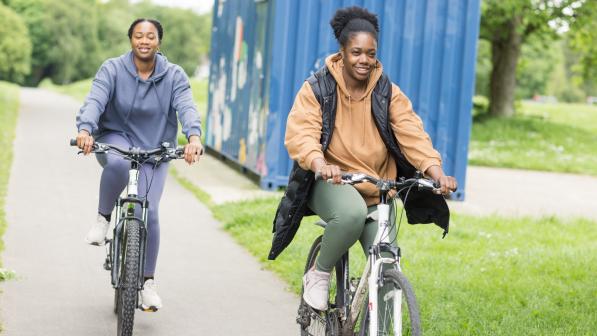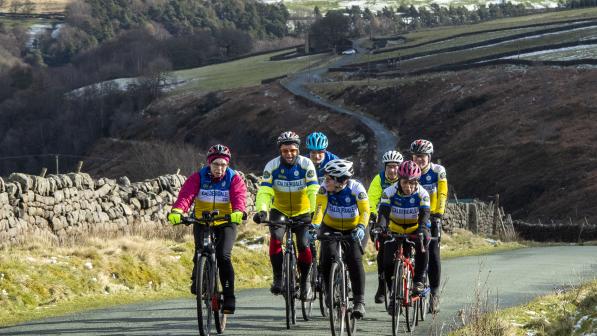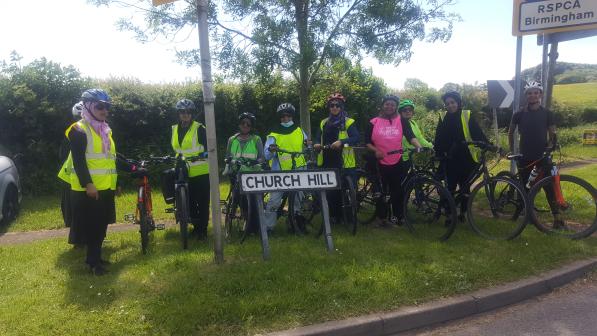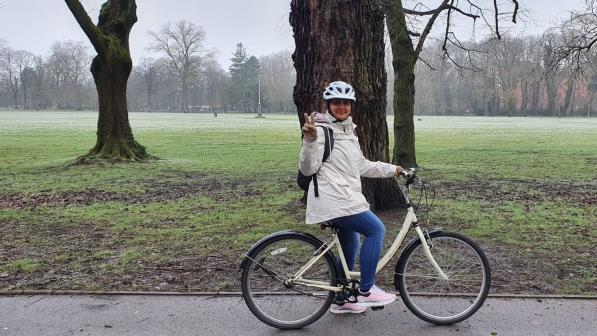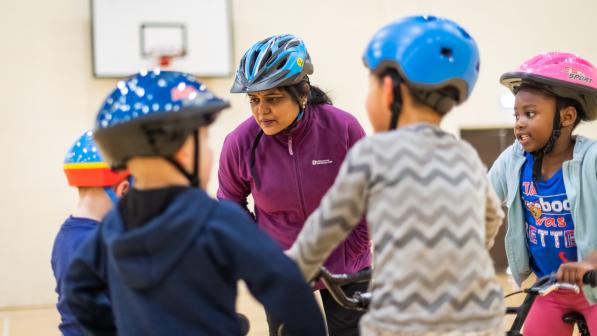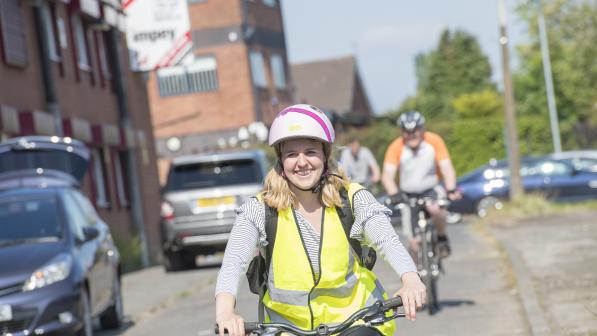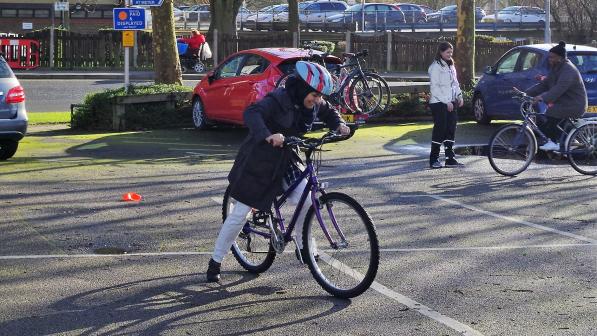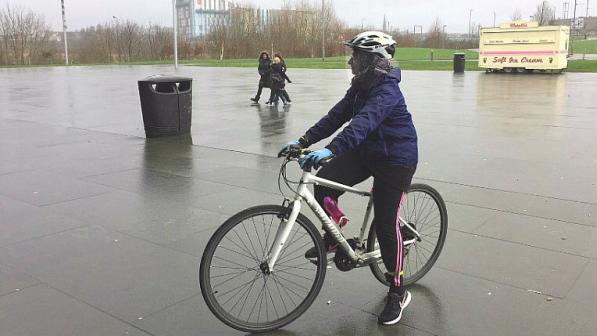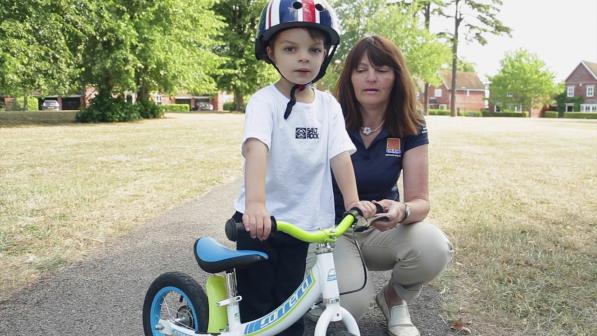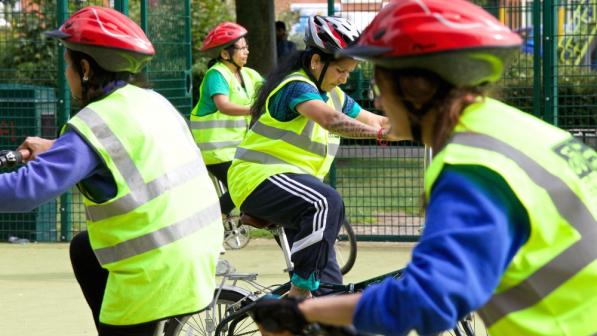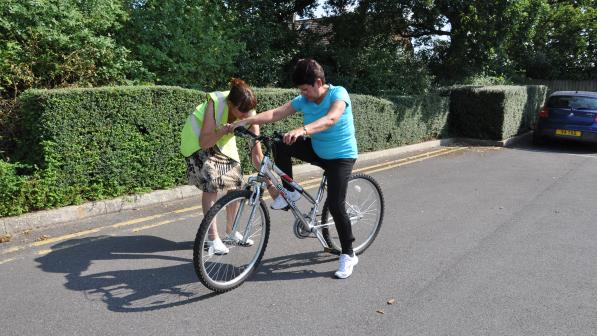Video: How to teach an adult to ride a bike
Watch our video (above) showing how to teach an adult to cycle by following Cycling UK’s 10 simple steps.
1. Location
First of all find the right location. You want ;a smooth, flat, paved surface, one without traffic, and ideally not many onlookers – a park or empty car park, for example.
2. Check the bike
Most bikes are suitable if they are the right size for the rider. Check that both brakes work, the tyres are pumped up and the saddle and headset aren’t loose or wobbly. Also check for wear in the rims or cracks in the frame. Spin the pedals round to ensure both they and the wheels move smoothly, and make sure the chain is oiled.
Ensure the trainee is comfortable sitting on the saddle with both feet touching the ground and can reach the brake levers. You may have to lower the saddle to its lowest point to start with – once the trainee is pedalling confidently, you can raise it again.
3. Check the rider
Check if the rider is wearing suitable clothing for cycling: will they be too hot or cold? Will their trouser legs get caught in the chain? Are their shoes sturdy enough? They don’t have to be in Lycra, just something comfy.
If they choose to wear a helmet, make sure it is on properly. Straps should be tight enough and the helmet should cover their forehead.
Ask if the rider feels ready to start the session. They should inform you of anything that might cause a problem such as a physical health concern, psychological issue or learning difficulty.
4. Getting on and off the bike
Tell them to stand with the bike on their right and hold onto the brakes with both hands to keep the bike steady while they lean the bike towards them and swing their right leg over the saddle until they are sitting comfortably on it. Reverse the process to dismount.
Practise getting on and off the bike until the rider is confident. For some people, this will be the first time they have ever actually sat on a bike and it may take some getting used to. If they are uncomfortable, or can’t reach the ground with their feet or the brakes with their hands, adjust the saddle, brake levers and handlebar accordingly, if you feel competent to do so.
Once they are pedalling comfortably, you can raise the saddle again so that they have a slight bend in the leg when their foot is on the pedal at its lowest point.
Encourage the trainee to put their weight over the back of the saddle, where the centre of gravity should be.
5. Walking with the bike
Ask them to have a go at walking slowly along with the bike, squeezing the brakes gently when they want to stop.
Get them to walk again and push on the ground using their feet. Remind them to look where they are going, not down at their feet, and to sit up and look straight ahead.
6. Scooting
On flat ground or a very gentle slope and encourage them to push down with their feet then lift them off the ground while they are moving forwards. You might have to hold the back of the saddle (ask permission first!) to help but try not to balance for them.
It helps to have something up ahead to focus on as learners will naturally want to look down at their feet, which means they will find it harder to balance.
Do this many times and they will naturally pick up speed until they are scooting the bike by lifting their feet off the ground – a gentle slope can help with this.
As they gain confidence, try to encourage longer intervals before they put their feet down. Teach them to keep their head up, back and tummy straight, hands relaxed and arms loose. Tell them not to grip the handlebars too tightly – it won’t help!
7. Learning to balance
Balance is achieved by moving the bike back under the rider so they should learn to turn the handlebars slightly in the direction of fall. However, balancing is an instinct that should be felt, rather than taught! Overthinking the process usually leads to tenseness.
Once they have mastered lifting their feet, you can help them to steer the bike by getting them to turn the handlebars gently.
If they struggle to lean, you can show them how they can balance without holding onto the handlebars by you holding the front wheel and handlebars while they take their hands off and sit upright on the saddle – this encourages them to sit up straight, rather than leaning forwards.
You may need to keep hold of the saddle and handlebar while they get the hang of it but try not to let them lean on you too much! Remember to encourage them by praising every bit of progress, no matter how small.
8. Starting off and pedalling
Once they are happy balancing unaided for a short distance, it’s time to start to introduce pedalling. Ask them to ‘set the pedal’ at the ‘two o’clock’ position by hooking their right (or left) foot under it and bringing it up so it’s level with the down tube.
You might have to help them move the pedal using your hands. Remind them they must plant their left foot firmly on the ground in order to balance – some people try to lift both feet off the ground before the bike is moving!
Now is the time to try to get the trainee to start riding: get them to release the brakes and push down the right (or left) pedal while looking straight ahead. After a count of one-two, they should then try to bring the left foot onto the pedal without looking down. Practise this several times until they can do so.
9. Riding unaided
Once the rider can turn the pedals and balance the bike by themselves, you can ask them to try riding unaided. They might need a gentle push to get some momentum if they can’t pedal fast enough – balancing at low speed is quite hard.
Keep nearby in case they wobble and remind them to keep their brakes covered all the time so they can stop quickly whenever they want.
You will know when the time is right to let go completely as the bike will feel light. You may have to remind them to keep pedalling, however, in order to keep the bike moving – some trainees might keep the brakes on, while others will have to be reminded to use the brakes to stop!
This can be a life-changing moment for the rider so give them – and you – time to enjoy it.
10. Keep practising
Keep practising for as long as the learner wants to – but always stop before they get tired or fed up. It’s always best to end a session when a little progress has been made, rather than keeping going until frustration sets in.
The brain may never have worked in this way before so it needs time to digest the new process. After a night’s sleep, it’s amazing how much more relaxed a learner will feel when they take to the saddle again and everything will be a whole lot easier as their confidence increases.
Next steps
Once the trainee is pedalling unaided, it may still be a while before they are confident in steering the bike in different directions. Again, remind them to look ahead and turn their head in the direction they want to go, rather than at objects they would rather avoid.
After a little bit of practice in a traffic-free area, it won’t be long before the rider will want to move on to learning how to slow down and stop correctly, signal, look behind and go round objects on the ground. They should master these skills before going out on the road, if possible.
This completes Level 1 of the National Standard in cycle training and shows they should be able to cope with light traffic conditions before embarking on Level 2, which is all about cycling on quiet streets.
Find an instructor
A National Standard cycle instructor is professionally trained to teach people of all ages and abilities to cycle more confidently; contact Bikeability or your local authority for advice as training offers differ from region to region.
There are also lots of delivery partners through Cycling UK’s Big Bike Revival project who may also offer learn to ride sessions, search for your nearest centre and get in touch today.
For more inspiration on learning to cycle as an adult, check out Alicia’s story.
